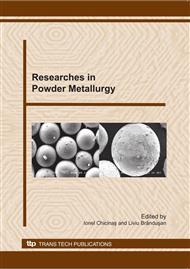p.39
p.47
p.55
p.59
p.63
p.68
p.72
p.76
p.80
The Influence of Cu-Coating versus Admixing on Mechanical Properties and Dimensional Change of Sintered Fe-Cu Parts
Abstract:
The differences in mechanical properties of pressed and sintered specimens made from mixtures of iron and copper powders or from copper-coated iron powders, produced by a cementation process, were studied. For this purpose different copper contents were used (3, 8 or 12wt%) and the oxygen content of the coated powders was measured. After sintering at 1120°C for 60 minutes in hydrogen flow, microgradient structures were observed. The samples were investigated by light optical microscopy and tested under bending and tensile loads. Young´s Moduli were calculated from resonance frequencies. The copper-coating of the iron powder results in an improvement of all properties, owing to a more homogeneous copper distribution and the absence of large secondary pores, compared to specimens made from mixtures of iron and copper powders. In the case of Fe-12Cu (coated), all determined properties tend to result in a maximum: highest sintered density (7,33 g/cm³), tensile strength (489 MPa), transverse rupture strength (1098 MPa) and apparent hardness (162 HV10). The Young´s Modulus (150 GPa) of coated Fe-12Cu is nearly the same as that of sintered iron (154 GPa).
Info:
Periodical:
Pages:
63-67
Citation:
Online since:
January 2011
Price:
Сopyright:
© 2011 Trans Tech Publications Ltd. All Rights Reserved
Share:
Citation:


